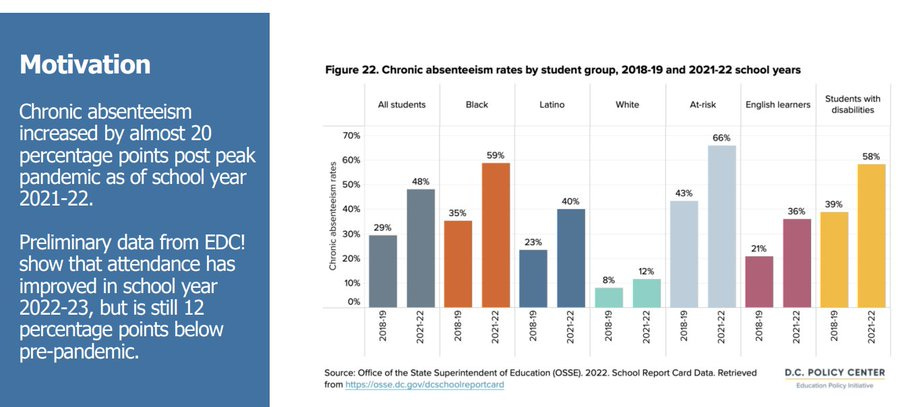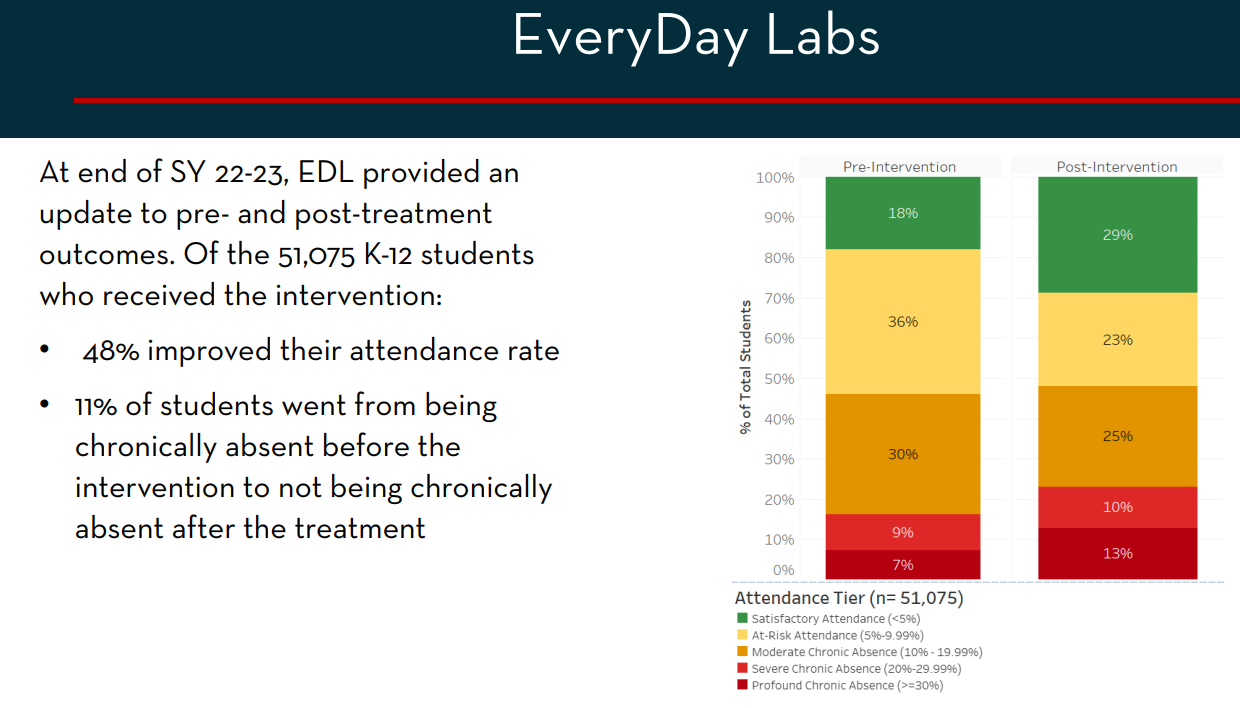Preventing crime by keeping kids in school
Absenteeism is way up and DC's attendance programs are failing
Shockingly high numbers of DC kids are chronically absent from school and this warning sign has largely been ignored in DC’s debate about youth crime. Comprehensive research of DC kids shows that missing even just 1 week of school correlates with much higher arrest rates. Unfortunately chronic absenteeism (missing 10% or more of the school year) is up significantly post-COVID with 17-24% increases among “At-Risk”, Black and Latino students. These increases are on top of an already high pre-COVID level of absenteeism; so in many schools over 90% of students are missing significant numbers of school days. Absences are a signal that something is going wrong in a child’s life and DC’s school/safety net “ecosystem” is failing to act on these signals. With elevated public concern about youth crime, and absenteeism’s negative impact on student outcomes, this topic deserves more attention.
Unfortunately this is a problem in both DC Public Schools (DCPS) and DC Public Charter Schools (DCPCS). DC schools usually release attendance data for the preceding school year in August. It is now mid-October and we still do not have these reports for the 2022-2023 school year. We also have no information about ongoing attendance to know if things are improving this school year. As a result, policymakers and parents are largely in the dark about this important issue. While truancy/absenteeism are high across both public and public charter schools, these system-wide averages mask the fact that the worst-off schools (often high schools) have much higher truancy and absenteeism rates (as we’ll see below):
When students have more unexcused absences from school it unsurprisingly correlates with much higher arrest rates. This finding comes from an excellent CJCC report on DC kids and it has some key implications:
Kids that are already higher-risk because of other factors (the “Quartile 4” line on the graph below) are much more likely to be arrested if they have a significant number of unexcused absences
Even relatively lower-risk kids (quartiles 1, 2 and 3) are relatively more likely to be arrested if they have more unexcused absences
It’s important to remember that most chronically absent kids do not end up getting arrested. Absenteeism is bad and correlates with increased odds that a kid will be arrested; but it does not mean that all or even most chronically absent kids are engaging in criminal activity.
Unexcused absences by themselves can lead to bad outcomes (i.e. if a student isn’t in school that is more opportunity for them to get into trouble) but absences are primarily a signal that something else is wrong in the child’s life. Very often the reason that a child is missing school is housing instability, transportation issues, physical health or mental health challenges that teachers have very little control over. These kinds of issues have a lot of overlap with what some call “the root causes of crime” which is often thrown around as a buzzword in crime debates. Used correctly, student absence data is a rare chance to detect where these “root causes” are harming a child’s development and should trigger a firm and compassionate response from DC’s safety net.
Unfortunately it does not appear that DC schools or government as a whole are consistently intervening with absent kids:
Absences were increasing steadily before COVID so DCPS leaders and Mayor Bowser knew this was a worsening problem for years
DC schools are required to refer truant students (those who miss a certain # of school days) to either Child and Family Services (CFSA) or Court Social Services depending on the child’s age. This requirement is supposed to ensure that the child’s family receives the appropriate services to fix the truancy problem. DCPS has been relatively consistent in referring ~80% of eligible younger children to CFSA. But DCPS has consistently been non-compliant when it comes to older children. Only between 28%-46% of eligible children (those with a large number of absences) have been referred to Court Social Services.
This failure to take high-school age truancy seriously is typically excused in DCPS’ annual reports by complaining about the paperwork requirements for Court Social Services referrals:
Language to this effect has been in every school year attendance report back to 2014-2015. Instead of fixing the process over the last decade, DCPS has made excuses. This failure to act on truancy among older kids may contribute to those students having much worse attendance rates:
There are some key differences between DC’s public high school population and younger grades that may explain some of the differences in attendance. But that doesn’t make the attendance problem less important or excuse DCPS’ failure to comply with court requirements. Again, this problem of extremely high absence rates in DC public high schools was evident before COVID despite DCPS’ attempt to ascribe most of this to the pandemic. Interestingly, the biggest increases in extreme absenteeism (21+ unexcused absences or an entire month of school) were in DC middle schools:
One nuance is that DC public high schools have very uneven grade distributions. In SY 2021-2022 there were only 1,911 12th graders compared to 4,254 9th graders (over 2X as many). This suggests there may be some “survivorship bias” skewing the data for the later grades. When we look by high school we see that some of the most disadvantaged schools have shockingly high absenteeism rates and low compliance in making required referrals for truancy:
One area for policymakers to investigate is the effectiveness of Court Social Services when DCPS does make a referral. There isn’t much detail about truancy referrals in the Family Court’s Annual Report but they do claim they “ensured all referrals for Truancy and PINS matters were pre-screened within 48 hours of receiving the referral.” This at least suggests relatively quick response times. Since DC schools’ efforts to reduce truancy aren’t working it’s worth exploring if increasing court referral compliance would help. If paperwork is the barrier that seems like something a determined organization could solve with automation or shifting resources.
Mayor Bowser has branded DC’s attendance strategy as “Mayor Bowser Presents Every Day Counts” and this taskforce meets every few months. In the taskforce’s September 2023 meeting they shared preliminary school year 2022-2023 data that suggests attendance improved somewhat but was still below the already-low pre-COVID rates. They also shared data about DC’s partnership with EveryDay Labs, which is a vendor tasked with intervening and preventing absences. Unfortunately their own data show the program has had little net impact:
This slide is a great example of how to spin a null result as something positive. Note that the slide highlights the 48% of students that improved without pointing out that 52% of students’ attendance got worse after the intervention. In the graph, note that there are more children in the (bad) Red and Orange categories post-intervention. Even more concerning, these stats got worse over time relative to the preliminary data they shared in April 2023. In April’s preliminary data at least a majority (58%) of students in the intervention group had improved their attendance rate but by the end of the year this had fallen to 48%. When a program has only a 50/50 chance of improving outcomes it’s highly likely that it has had no real effect; especially since there does not appear to be a control group for comparison. However EveryDay Labs got their partnership extended with DC schools based on the preliminary data so this seemingly-ineffective intervention will continue to be one of DC’s main tools to fight truancy.
EveryDay Labs’s inability to increase attendance makes the Bowser Administration’s over 50% cut to DC’s Truancy Reduction program more concerning. This program seemingly has large problems, only serving 8% of DC’s chronically absent students according to the Council’s committee report for the Fiscal Year 2024 budget:
It’s unclear how the administration plans for this program to reach more students with less than half last year’s funding. The “Show Up, Stand Up” program noted in the September 2023 “Every Day Counts” taskforce meeting that “Due to a reduction in funding, grantees will assign one staff member to a priority school and other schools will have a 1:2 ratio (1 staff member assigned to 2 schools) staffing coverage plan.” It’s also disappointing that this agency has set performance targets that are lower than their current performance. This is a depressingly common situation across multiple DC government agencies that strongly suggests their “performance plans” are not serious documents:
DC’s Office of the Attorney General (OAG) also plays a role in truancy reduction. Here are some of the efforts they described in a 2022 hearing:
“OAG refers eligible cases to the Department of Behavioral Health’s (DBH) High-Fidelity Wrap program or the Department of Human Services’ (DHS) Alternatives to the Court Experience (ACE) Diversion Program.”
The “I Belong HERE! Program” which “aims to increase school spirit, provide students with incentives for attending school, and present monthly lessons”
ATTEND “a district-wide diversion program for parents referred for criminal prosecution for failing to ensure daily attendance of their younger school-aged children”
“Prosecution as a last resort” when diversion and other programs fail
DC’s approach appears to be based on research that shows more punitive measures like out-of-school suspensions are ineffective at combatting truancy since they often “push” the student out of school. However it is worth asking how well schools and OAG are ensuring accountability for truant students and their parents. DOJ research does show that “in-school suspension policies, detention, and use of alternative school programs each allow students to continue academic progress in the school setting rather than having unsupervised time outside of it.” While helping students and their families overcome obstacles to attendance is a key part of truancy reduction; it’s also important that schools uphold norms about attendance in a constructive way.
Hopefully student truancy will get the attention it deserves from policymakers and the media. There’s enormous concern about youth crime in DC and education is always a top concern of many Washingtonians. Even if crime weren’t a concern, the learning loss from missing school (and resulting drops in test scores) should make this a priority. Attendance data is a rare opportunity to see where problems are popping up in a child’s life and should be a trigger for DC’s safety net to get to work. This is a topic where all factions of DC’s politics ostensibly agree on the outcome (kids are in school) so it should be possible for positive, constructive action. The lagged and limited data we have suggests DC’s current efforts are not working and the steep cuts in this year’s budget are an ominous sign. The burden of proof should be on the administration to prove that attendance this school year is on track after the last several years of scandalously high absenteeism and truancy rates.














